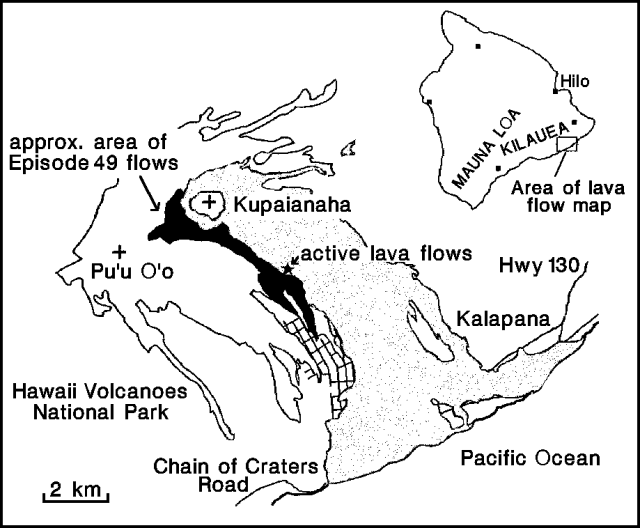Report on Kilauea (United States) — December 1991
Bulletin of the Global Volcanism Network, vol. 16, no. 12 (December 1991)
Managing Editor: Lindsay McClelland.
Kilauea (United States) Small lava flows emerge from tube system; new lava covers Pu`u `O`o Crater floor
Please cite this report as:
Global Volcanism Program, 1991. Report on Kilauea (United States) (McClelland, L., ed.). Bulletin of the Global Volcanism Network, 16:12. Smithsonian Institution. https://doi.org/10.5479/si.GVP.BGVN199112-332010
Kilauea
United States
19.421°N, 155.287°W; summit elev. 1222 m
All times are local (unless otherwise noted)
Lava production . . . continued as of early January, but at a steadily declining rate (figure 84). December surface activity was limited to a continuation of the lava breakouts . . . from the main (Wahaula) tube at ~570 m (1,860 ft) elevation. The breakouts had initially produced viscous, spiny pahoehoe that accumulated near the tube, but a change to fluid pahoehoe at the beginning of December persisted for the rest of the month despite a continued decline in volume. The longest flows from this site reached ~500 m (1,660 ft) elevation during the first week in December, but later flows generally did not extend below 530 m (1,750 ft) asl.
Lava production in the bottom of Pu`u `O`o crater was temporarily halted by collapse associated with the E-49 fissure eruption. Renewed activity in Pu`u `O`o was first observed on 4 December and increased through the month, although it was not as vigorous as in September and October. The former lava pond remained empty, but a former vent N of the pond and a new vent against the SW crater wall were sources of activity ranging from low-volume spattering to upwelling of crater-floor lava flows. Toward the end of December, flows from both vents were frequently observed cascading into the former lava pond. The crater floor, which had been covered with talus after dropping at least 20 m, was gradually resurfaced with fresh pahoehoe. By the end of the month, most of the rockfall rubble was covered and the crater floor was nearly flat.
Low-amplitude volcanic tremor continued in the East rift zone. After a modest swarm of long-period summit earthquakes at 5-13 km depth 7-17 December, increased shallow (<5 km deep) microearthquake activity was observed along the East rift zone ~2-5.5 km from the summit crater rim (between Puhimau and Pauahi craters). This segment of the East rift zone had persistently shown low levels of seismicity, but the number of events had greatly decreased after the onset of E-49. An increase in shallow, long-period summit events began the last week in December. Their number peaked 31 December-1 January, totaling nearly 400, then decreased later that week.
Geological Summary. Kilauea overlaps the E flank of the massive Mauna Loa shield volcano in the island of Hawaii. Eruptions are prominent in Polynesian legends; written documentation since 1820 records frequent summit and flank lava flow eruptions interspersed with periods of long-term lava lake activity at Halemaumau crater in the summit caldera until 1924. The 3 x 5 km caldera was formed in several stages about 1,500 years ago and during the 18th century; eruptions have also originated from the lengthy East and Southwest rift zones, which extend to the ocean in both directions. About 90% of the surface of the basaltic shield volcano is formed of lava flows less than about 1,100 years old; 70% of the surface is younger than 600 years. The long-term eruption from the East rift zone between 1983 and 2018 produced lava flows covering more than 100 km2, destroyed hundreds of houses, and added new coastline.
Information Contacts: C. Heliker and P. Okubo, HVO.


